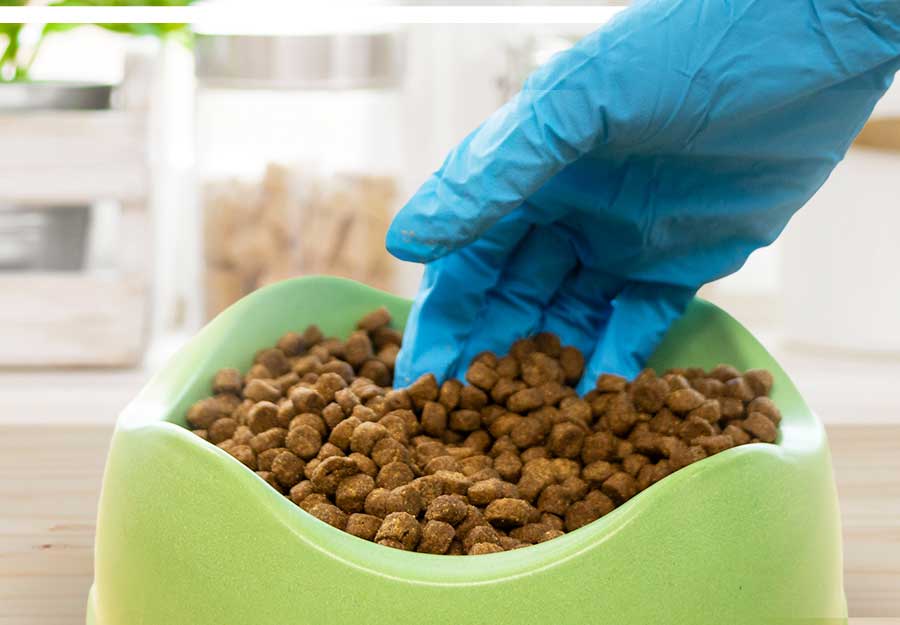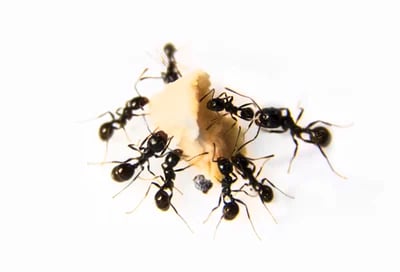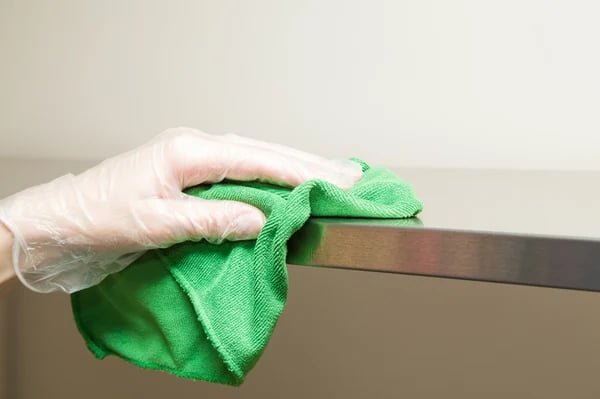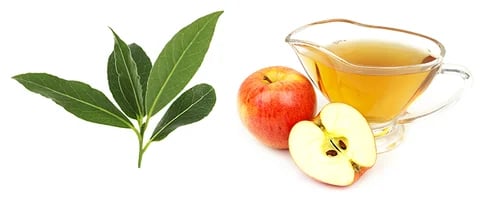
Wondering how some pesky bugs made it into your dog's dinner? Bugs in dry dog food are more common than you think, but it's also easy to prevent. Keep reading to find out how!
You may have noticed a bug or two in your dog’s food bowl, or maybe even a beetle crawling around your pantry. We often chalk it up to seasonal changes driving pests indoors, but don’t dismiss these little creatures too quickly, and don’t be surprised if you find these bugs in dry food.It’s natural to be alarmed by bug sightings in your home, but try not to panic just yet. We connected with an Entomologist from Orkin Canada, to help you understand what kind of bugs you're dealing with and how to prevent and get rid of them for good or How to keep ants out of dog food bowl outside.
Common Bugs in Dog Food
1. Warehouse Beetles

The most common bug that you’ll find in your dog’s food, treats, and even your own dry goods, is called a warehouse beetle. Aptly named, the warehouse beetle can be found in any area where dry food goods are stored, like a warehouse, cupboard, basement, or garage.
Any type of pest infestation can give us the heebie-jeebies, but these little pests can be even more troublesome than you may think.
For starters, they are survivors. Being scavenging beetles, they are used to living in poor conditions and can find food and shelter where other pests can't.
Their lifecycle is only about 35-40 days, but an adult warehouse beetle can enter into a protective hibernation-like state called facultative diapause. They can survive in this state much longer than their typical life span.
Early detection of bugs in dog food is important. The females can lay up to 100 eggs in a food source, and the eggs typically hatch in about 6 days, so they have the ability to spread quickly.
If you're getting itchy just reading this, then you may not want to know that the fine hairs on their body, called setae, are shed throughout their lifecycle.
In large quantities, setae can irritate your pet's respiratory system and gastrointestinal tract, so dealing with these pests before they get out of control is safer for you and your pets.
2. Ants

Warm weather tends to bring out these pests. Ants can be relentless; once they find a way in, they’ll keep coming. Ants are not uncommon, and most of us have dealt with these intruders sneaking into our homes at some point. For the most part, ants are pretty harmless, albeit annoying.
If you find ants in your pet’s food bowl, stay calm. The good thing is that ants in small numbers aren't harmful if your dog eats them; they are gross but technically safe. This doesn’t mean that your pet should be eating ants, just that it won’t hurt them if they accidentally ingest some of these creepy crawlies with their food.
Ants are attracted to many different food sources but aren’t as good at tunnelling into things as beetles. It’s less likely that you’ll find them in a sealed bag or container, but if you leave an open container of food or an unsealed bag on the floor, then the ants will jump on that opportunity.
How did they get in there?
Warehouse beetles can get into just about anything. They burrow into anything they think could be a sustainable food source. Dry dog food goes through a number of warehouses before making it to your pet store, and the beetles may have entered the food at any point along the way.
Ants are a little less clever but will be glad to feast on any open food. If you leave kibble out for your pet to graze, you will likely find a few ants in their bowl.
You should routinely check your dog’s dry goods for any signs of pest activity. You may not always find live bugs, but you will likely find dead bugs, sheds, or packaging that has clearly been tunnelled into.
If you see any type of bug activity, dispose of the product immediately. Once a food item has been infested, it is unsalvageable and should be removed from the house to prevent the infestation from spreading. Just because you can't see them doesn't mean they aren't there.
Eliminating the Threat

Any cupboard, shelving, or spaces that hold contaminated product needs to be thoroughly sanitized and then vacuumed.
Remove everything from the storage area and use a strong vinegar and water solution to disinfect the area. A 10% vinegar and water mixture will clean the area and won’t be toxic or harmful to your pets or their food products. Pay special attention to the cracks, corners, edges, and any area that the pests could hide.
Once the shelves are clean, vacuum the whole area to ensure that you have removed any beetles or eggs that could be hiding.
10 Tips for Preventing a Pest Infestation
If you’ve never experienced any kind of pests in your dog’s food, that’s great, but don’t think that it will never happen. Be proactive to make sure that your pets and their food are safe from these relentless insects.
Preventing insects from infesting your home is much easier than trying to get rid of them once they show up. Follow these simple tricks to avoid the headache of bugs in dog food:
- Check your pet’s products when you get them home. Even if you don’t plan to use them right away, open them and check them. If you find evidence of pests, return the product to the store where it was purchased from.
- Proper storage is an effective deterrent for pests. Avoid storing your pet products in their original containers. The bags and boxes they are purchased in are easily breached by warehouse beetles and many other pests. Use a glass, metal, or thick plastic air-tight container.
- Don't stockpile your pet's food. “The longer your pet food sits around your home, the more likely it is to become infested,” according to the Orkin team.
- Sanitize your storage containers regularly. Every time you empty the container, make sure that you are cleaning it before refilling it. Use a natural disinfectant like vinegar to prevent leaving a soapy residue in the container.
- Bugs are susceptible to extreme temperatures. If you like to buy value sizes, then only keep out what you need and freeze the rest in freezer bags. This will not only keep pests out, but it will keep the product fresh.
- Another hot tip from Orkin is, “Feed your pet only what they can eat and finish. Clean up after your pet is done eating.” If your pet is a grazer and prefers to leave food out all day, just know that it could attract bug activity.
- Regularly inspect the areas where you store your pet food. Clean up crumbs and spills to avoid attracting pests, and keep your pet's food in a different area than your food.
- Always store pet products in a dry area. Eggs require a humid environment to hatch. Moist areas also allow mould and bacteria to grow, which can also contaminate your and your pet's products.
- Previous infestations can leave behind survivors. Even if you think you’ve eradicated the population, some stragglers may be waiting for an opportune time to start spreading again. If you are unsure whether you could completely rid your home of these pesky bugs, then contact a professional exterminator like Orkin. They will be able to assess your home, look for hidden clues of pest survival, and recommend the best course of action for both prevention and elimination.
- Regularly inspect your pet. Through routine grooming or petting, check your pet for pest activity. Warehouse beetles and ants will generally not choose your pet’s body as a suitable habitat, but they could be trying to hitch a ride. You can also check for things like lice, fleas, and mites. Talk to your vet if you notice your pet is itchier than normal or is showing bug bite symptoms.
Natural Pest Deterrents

There are tons of pest repellents, insecticides and other chemicals that can prevent bugs from infesting your home, but when it comes to your pet's food, you have to make sure that these products won’t harm your pet. Here are some natural pest-deterring products that can help reduce the risk of infestation:
- Bay Leaves
- Diatomaceous Earth
- Apple Cider Vinegar
- Peppermint Oil
These natural deterrents can be placed around your home in storage containers, pantries, and cupboards. Avoid putting bay leaves or peppermint oil directly in your pet's food. Apple cider should be diluted, a 1:10 ratio, before letting your pet ingest it.
Remember that the point is not for your pet to consume the deterrents but for them to be near food to prevent pest infestations.
Natural deterrents may not be as effective as traditional pest control products. Results can vary depending on the type and concentration of the pest. If you have not gotten the desired results from a natural pest deterrent, speak with a professional to determine the right pet-safe preventative measures.
Exterminate Your Pest Problem
If you’ve tried everything to eliminate your pest problem or don't know where to start, it’s time to call an expert. The professional team at Orkin Canada will work with you to identify the pests and recommend a proper course of action to eliminate them.
Don’t wait too long. Take action at the first signs of an infestation to prevent it from getting exponentially worse.
Frequently Asked Questions
Are bugs in dog food safe for dogs to consume?
In most cases, bugs in dog food are not harmful to dogs. Dogs have a more robust digestive system than humans and can handle certain levels of insects without adverse effects.
Why are there bugs in my dog's food?
Bugs can sometimes find their way into dog food during the manufacturing, packaging, or storage process. Ingredients used in pet food production might have small insects present, and if proper storage practices are not followed, bugs can infest the food.
Should I still feed my dog the food if I find bugs in it?
If you find bugs in your dog's food, it's best to stop feeding that specific batch of food to your dog.
How can I prevent bugs from getting into my dog's food?
To prevent bugs from infesting your dog's food, store it in an airtight container in a cool, dry place. Check the packaging for any signs of damage or tears before purchasing.
Can bugs in dog food be harmful to humans?
While bugs in dog food are generally not harmful to dogs, they can be a concern for humans if the food is inadvertently consumed. If you're handling your dog's food, practice good hygiene by washing your hands after touching it and avoiding cross-contamination with human food.
Should I report finding bugs in my dog's food to the manufacturer?
Yes, it's important to report the presence of bugs in your dog's food to the manufacturer. This helps the brand investigate the issue and potentially address any problems in their manufacturing or storage processes.
.png?width=200&height=66&name=logo%20(1).png)


.jpg)
